LEXUS LS500 2020 Owners Manual
Manufacturer: LEXUS, Model Year: 2020, Model line: LS500, Model: LEXUS LS500 2020Pages: 516, PDF Size: 10.38 MB
Page 111 of 516
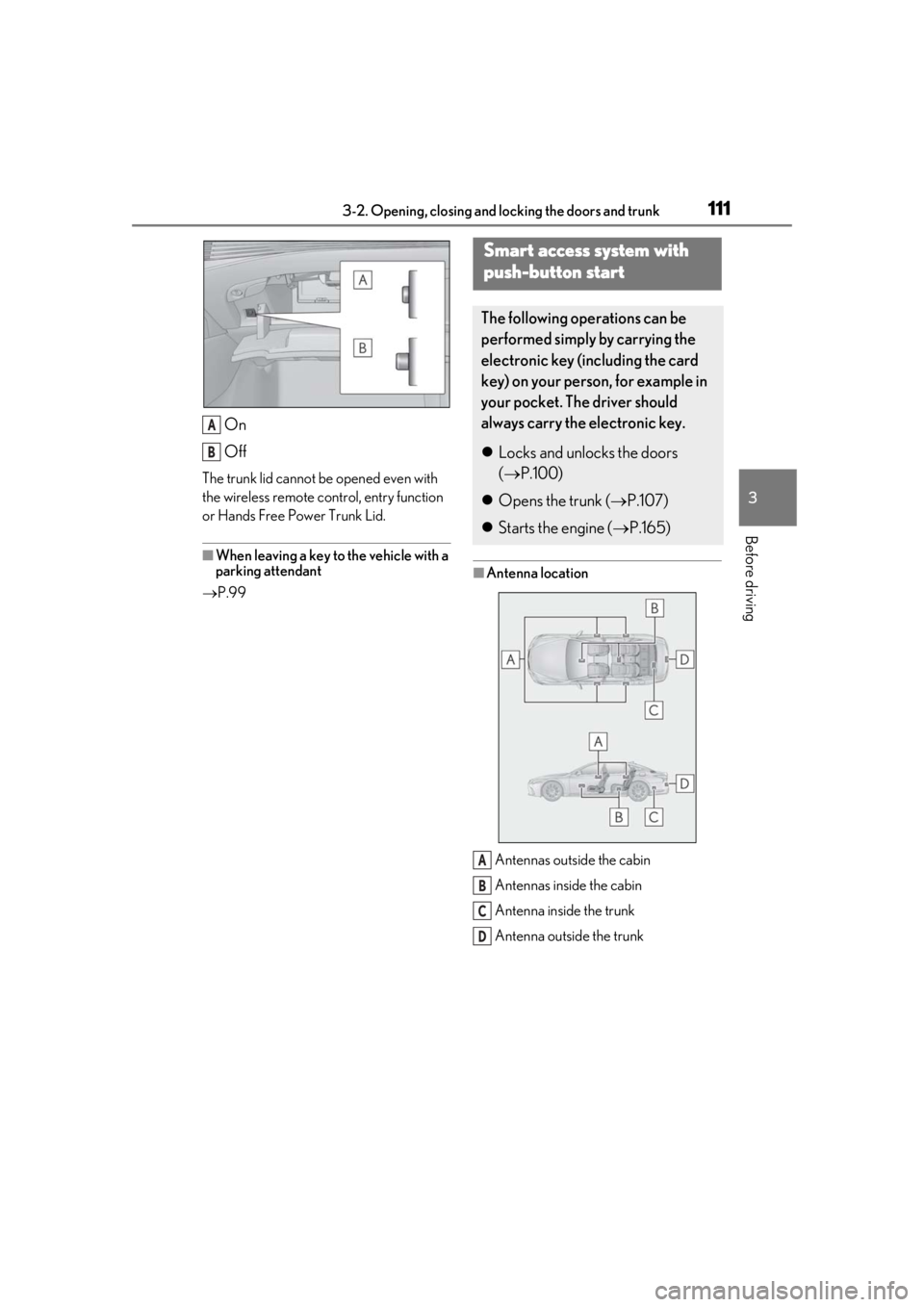
1113-2. Opening, closing and locking the doors and trunk
3
Before driving
On
Off
The trunk lid cannot be opened even with
the wireless remote control, entry function
or Hands Free Power Trunk Lid.
â When leaving a key to the vehicle with a
parking attendant
ï® P.99
â Antenna location
Antennas outside the cabin
Antennas inside the cabin
Antenna inside the trunk
Antenna outside the trunk
A
B
Smart access system with
push-button start
The following operations can be
performed simply by carrying the
electronic key (including the card
key) on your person, for example in
your pocket. The driver should
always carry the electronic key.
ï¬ Locks and unlocks the doors
(ï® P.100)
ï¬ Opens the trunk ( ï®P.107)
ï¬ Starts the engine (ï® P.165)
A
B
C
D
Page 112 of 516
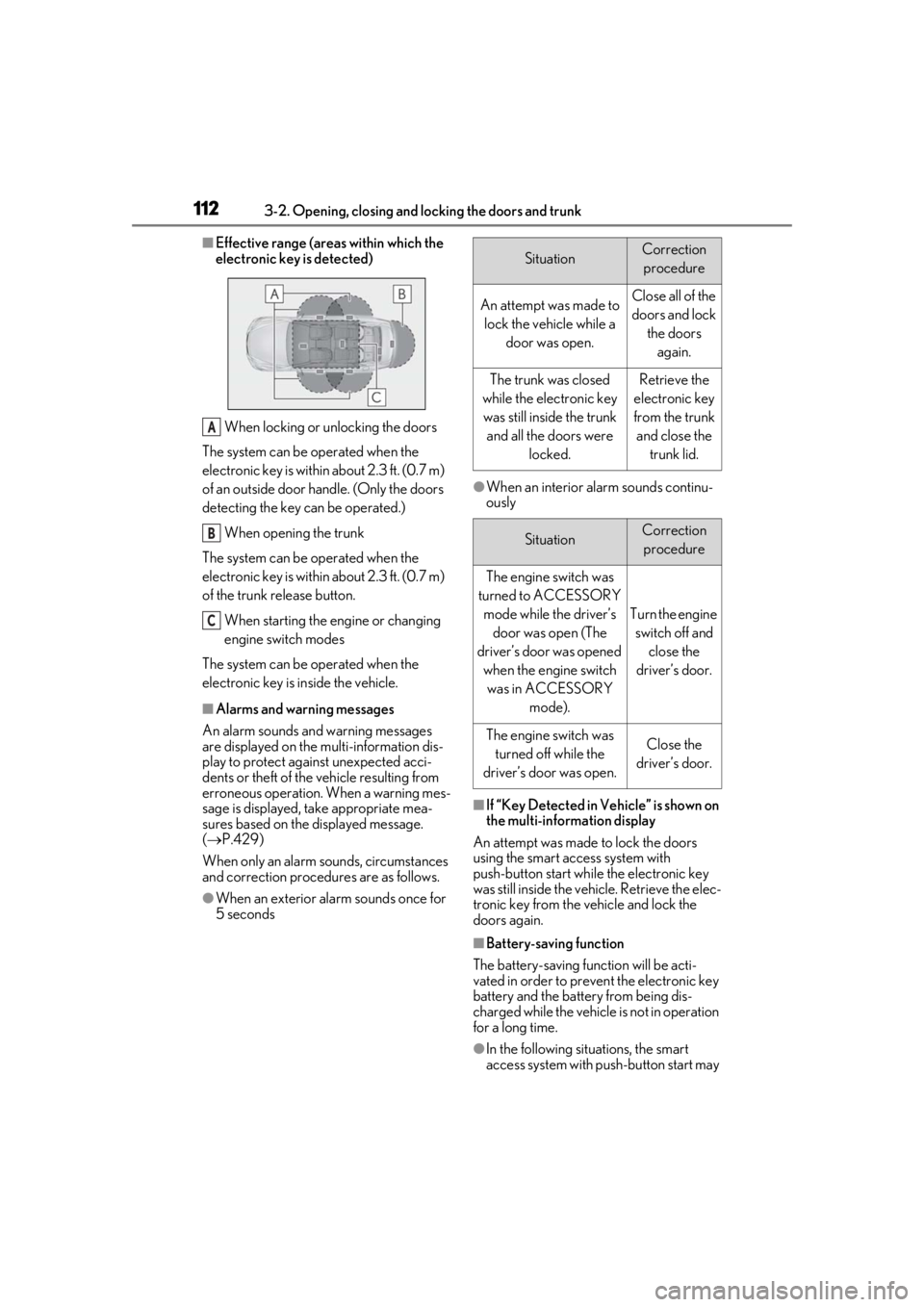
1123-2. Opening, closing and locking the doors and trunk
â Effective range (areas within which the
electronic key is detected)
When locking or unlocking the doors
The system can be operated when the
electronic key is within about 2.3 ft. (0.7 m)
of an outside door handle. (Only the doors
detecting the key can be operated.)
When opening the trunk
The system can be operated when the
electronic key is within about 2.3 ft. (0.7 m)
of the trunk release button.
When starting the engine or changing
engine switch modes
The system can be operated when the
electronic key is inside the vehicle.
â Alarms and warning messages
An alarm sounds and warning messages
are displayed on the multi-information dis-
play to protect against unexpected acci-
dents or theft of the vehicle resulting from
erroneous operation. When a warning mes-
sage is displayed, take appropriate mea-
sures based on the displayed message.
( ï® P.429)
When only an alarm sounds, circumstances
and correction procedures are as follows.
âWhen an exterior alarm sounds once for
5 seconds
âWhen an interior alarm sounds continu-
ously
â If âKey Detected in Vehicleâ is shown on
the multi-information display
An attempt was made to lock the doors
using the smart access system with
push-button start while the electronic key
was still inside the vehicle. Retrieve the elec-
tronic key from the vehicle and lock the
doors again.
â Battery-saving function
The battery-saving function will be acti-
vated in order to prevent the electronic key
battery and the battery from being dis-
charged while the vehicle is not in operation
for a long time.
âIn the following situations, the smart
access system with pu sh-button start may
A
B
C
SituationCorrection
procedure
An attempt was made to lock the vehicle while a door was open.Close all of the doors and lock the doors again.
The trunk was closed
while the electronic key was still inside the trunk and all the doors were locked.Retrieve the
electronic key
from the trunk and close the trunk lid.
SituationCorrection procedure
The engine switch was
turned to ACCESSORY mode while the driverâs door was open (The
driverâs door was opened when the engine switch was in ACCESSORY mode).
Turn the engine switch off and close the
driverâs door.
The engine switch was turned off while the
driverâs door was open.Close the
driverâs door.
Page 113 of 516
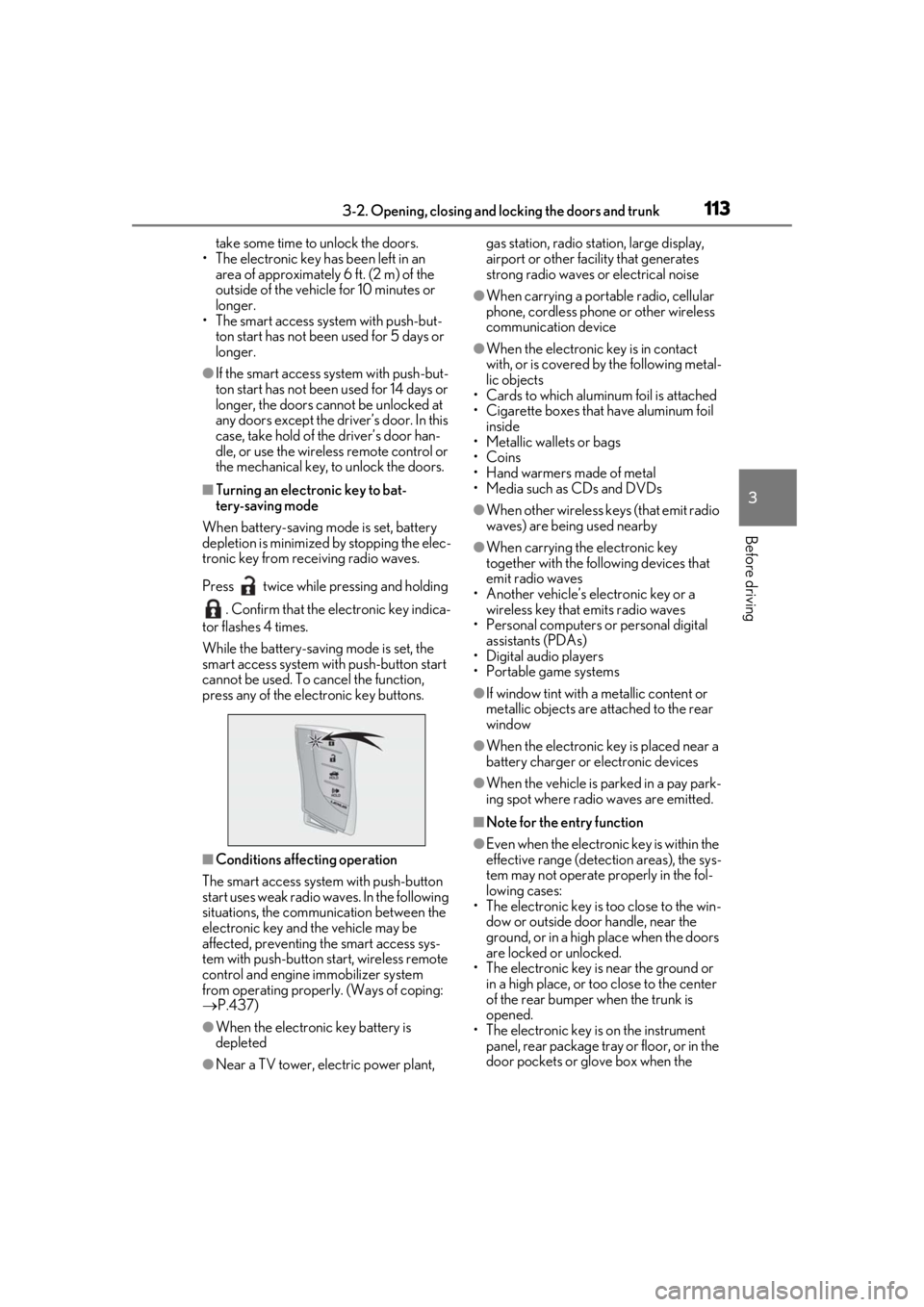
1133-2. Opening, closing and locking the doors and trunk
3
Before driving
take some time to unlock the doors.
⢠The electronic key has been left in an area of approximately 6 ft. (2 m) of the
outside of the vehicle for 10 minutes or
longer.
⢠The smart access system with push-but-
ton start has not been used for 5 days or
longer.
âIf the smart access system with push-but-
ton start has not been used for 14 days or
longer, the doors cannot be unlocked at
any doors except the driverâs door. In this
case, take hold of the driverâs door han-
dle, or use the wireless remote control or
the mechanical key, to unlock the doors.
â Turning an electronic key to bat-
tery-saving mode
When battery-saving mode is set, battery
depletion is minimized by stopping the elec-
tronic key from re ceiving radio waves.
Press twice while pressing and holding . Confirm that the electronic key indica-
tor flashes 4 times.
While the battery-saving mode is set, the
smart access system with push-button start
cannot be used. To cancel the function,
press any of the electronic key buttons.
â Conditions affe cting operation
The smart access system with push-button
start uses weak radio waves. In the following
situations, the communication between the
electronic key and the vehicle may be
affected, preventing the smart access sys-
tem with push-button start, wireless remote
control and engine immobilizer system
from operating properly. (Ways of coping:
ï® P.437)
âWhen the electronic key battery is
depleted
âNear a TV tower, electric power plant, gas station, radio stat
ion, large display,
airport or other fac ility that generates
strong radio waves or electrical noise
âWhen carrying a portable radio, cellular
phone, cordless phone or other wireless
communication device
âWhen the electronic key is in contact
with, or is covered by the following metal-
lic objects
⢠Cards to which aluminum foil is attached
⢠Cigarette boxes that have aluminum foil
inside
⢠Metallic wallets or bags
â¢Coins
⢠Hand warmers made of metal
⢠Media such as CDs and DVDs
âWhen other wireless keys (that emit radio
waves) are being used nearby
âWhen carrying the electronic key
together with the following devices that
emit radio waves
⢠Another vehicleâs electronic key or a wireless key that emits radio waves
⢠Personal computers or personal digital assistants (PDAs)
⢠Digital audio players
⢠Portable game systems
âIf window tint with a metallic content or
metallic objects are attached to the rear
window
âWhen the electronic key is placed near a
battery charger or electronic devices
âWhen the vehicle is parked in a pay park-
ing spot where radio waves are emitted.
â Note for the entry function
âEven when the electronic key is within the
effective range (detection areas), the sys-
tem may not operate properly in the fol-
lowing cases:
⢠The electronic key is too close to the win- dow or outside door handle, near the
ground, or in a high place when the doors
are locked or unlocked.
⢠The electronic key is near the ground or in a high place, or too close to the center
of the rear bumper when the trunk is
opened.
⢠The electronic key is on the instrument
panel, rear package tray or floor, or in the
door pockets or glove box when the
Page 114 of 516

1143-2. Opening, closing and locking the doors and trunk
engine is started or engine switch modes
are changed.
âDo not leave the electronic key on top of
the instrument panel or near the door
pockets when exiting the vehicle.
Depending on the radio wave reception
conditions, it may be detected by the
antenna outside the cabin and the doors
will become lockable from the outside,
possibly trapping the electronic key
inside the vehicle.
âAs long as the electron ic key is within the
effective range, the doors may be locked
or unlocked by anyone. However, only
the doors detecting the electronic key
can be used to unlock the vehicle.
âEven if the electronic key is not inside the
vehicle, it may be possible to start the
engine if the electronic key is near the
window.
âThe doors may unlock or lock if a large
amount of water spla shes on the door
handle, such as in the rain or in a car
wash, when the electronic key is within
the effective range. (The doors will auto-
matically be locked after approximately
60 seconds if the d oors are not opened
and closed.)
âIf the wireless remote control is used to
lock the doors when the electronic key is
near the vehicle, there is a possibility that
the door may not be unlocked by the
entry function. (Use the wireless remote
control to unlock the doors.)
âTouching the door lock sensor while
wearing gloves may delay or prevent lock
operation.
âWhen the lock operation is performed
using the lock sensor, recognition signals
will be shown up to two consecutive
times. After this, no recognition signals
will be given.
âIf the door handle becomes wet while the
electronic key is within the effective
range, the door may lock and unlock
repeatedly. In this case, follow the follow-
ing correction procedures to wash the
vehicle:
⢠Place the electronic key in a location 6 ft. (2 m) or more away from the vehicle.
(Take care to ensure that the key is not stolen.)
⢠Set the electronic key to battery-saving mode to disable the smart access system
with push-button start. ( ï®P.113)
âIf the electronic key is inside the vehicle
and a door handle becomes wet during a
car wash, a message may be shown on
the multi-information display and a
buzzer will sound outside the vehicle. To
turn off the alarm, lock all the doors.
âThe lock sensor may not work properly if
it comes into contact with ice, snow, mud,
etc. Clean the lock sensor and attempt to
operate it again.
âA sudden approach to the effective
range or door handle may prevent the
doors from being unlocked. In this case,
return the door handle to the original
position and check that the doors unlock
before pulling the door handle again.
âIf there is another electronic key in the
detection area, it may take slightly longer
to unlock the doors after the door handle
is gripped.
â When the vehicle is not driven for
extended periods
âTo prevent theft of the vehicle, do not
leave the electronic key within 6 ft. (2 m)
of the vehicle.
âThe smart access system with push-but-
ton start can be deactivated in advance.
âSetting the electronic key to battery-sav-
ing mode helps to reduce key battery
depletion. ( ï®P.113)
â To operate the system properly
âMake sure to carry the electronic key
when operating the system. Do not get
the electronic key too close to the vehicle
when operating the system from the out-
side of the vehicle.
Depending on the position and holding
condition of the electr onic key, the key may
not be detected correctly and the system
may not operate properly. (The alarm may
go off accidentally, or the door lock pre-
vention function may not operate.)
âDo not leave the electr onic key inside the
trunk.
Page 115 of 516
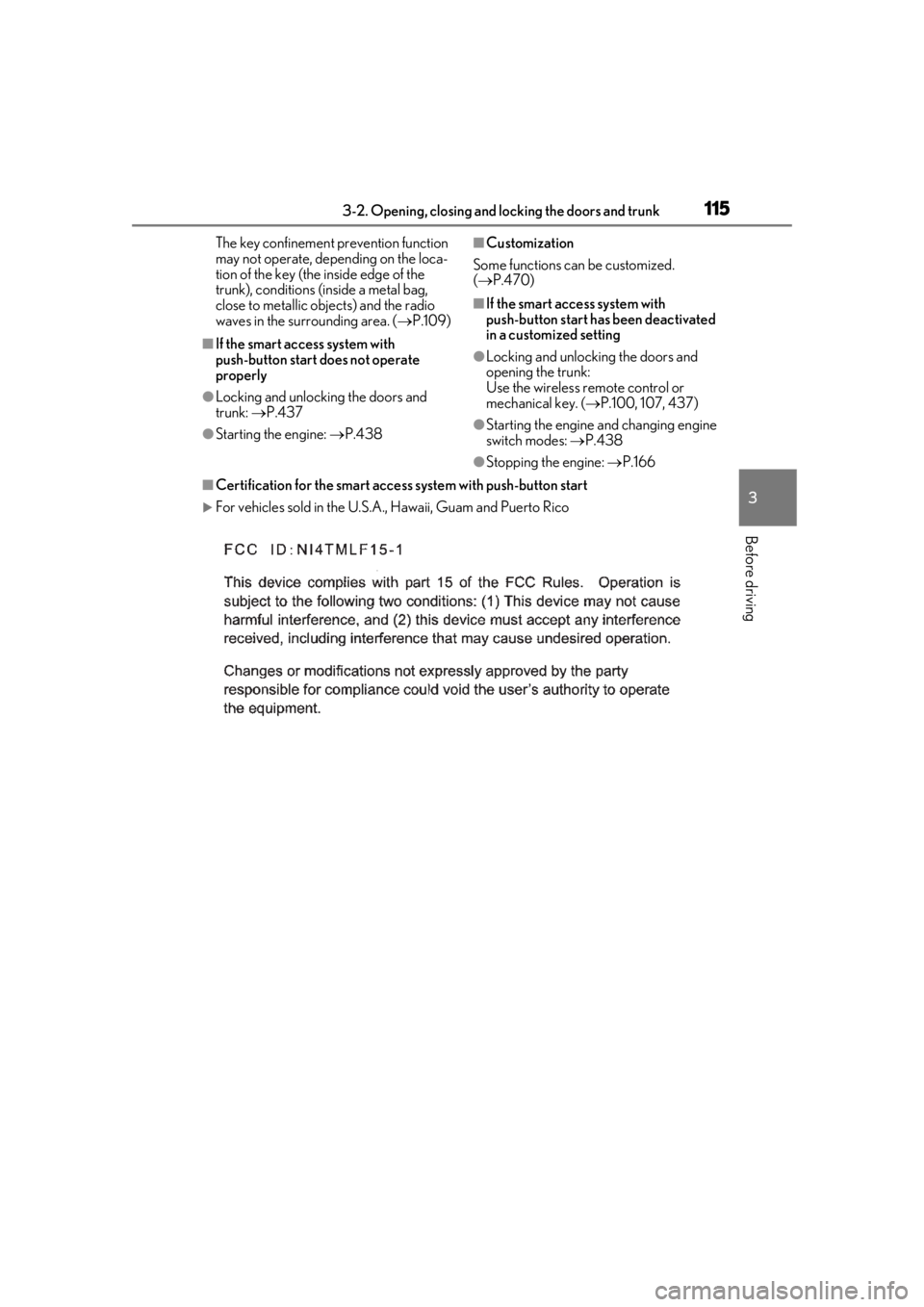
1153-2. Opening, closing and locking the doors and trunk
3
Before driving
The key confinement prevention function
may not operate, depending on the loca-
tion of the key (the inside edge of the
trunk), conditions (inside a metal bag,
close to metallic objects) and the radio
waves in the surrounding area. ( ï®P.109)
â If the smart access system with
push-button start does not operate
properly
âLocking and unlocking the doors and
trunk: ï®P.437
âStarting the engine: ï® P.438
â Customization
Some functions can be customized.
( ï® P.470)
â If the smart access system with
push-button start has been deactivated
in a customized setting
âLocking and unloc king the doors and
opening the trunk:
Use the wireless remote control or
mechanical key. ( ï®P.100, 107, 437)
âStarting the engine and changing engine
switch modes: ï® P.438
âStopping the engine: ï®P.166
â Certification for the smart access system with push-button start
ïµFor vehicles sold in the U.S.A., Hawaii, Guam and Puerto Rico
Page 116 of 516
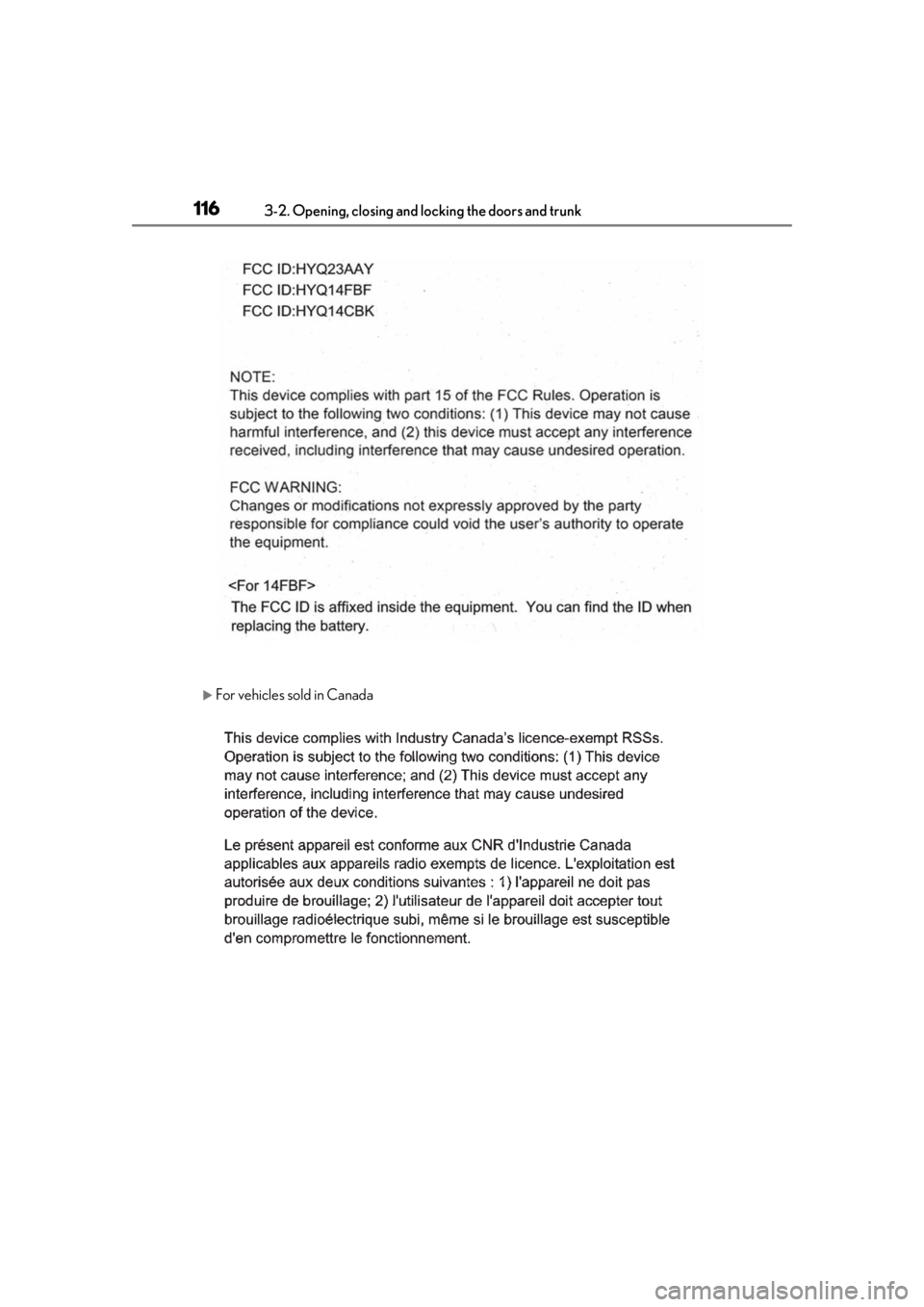
1163-2. Opening, closing and locking the doors and trunk
ïµFor vehicles sold in Canada
Page 117 of 516
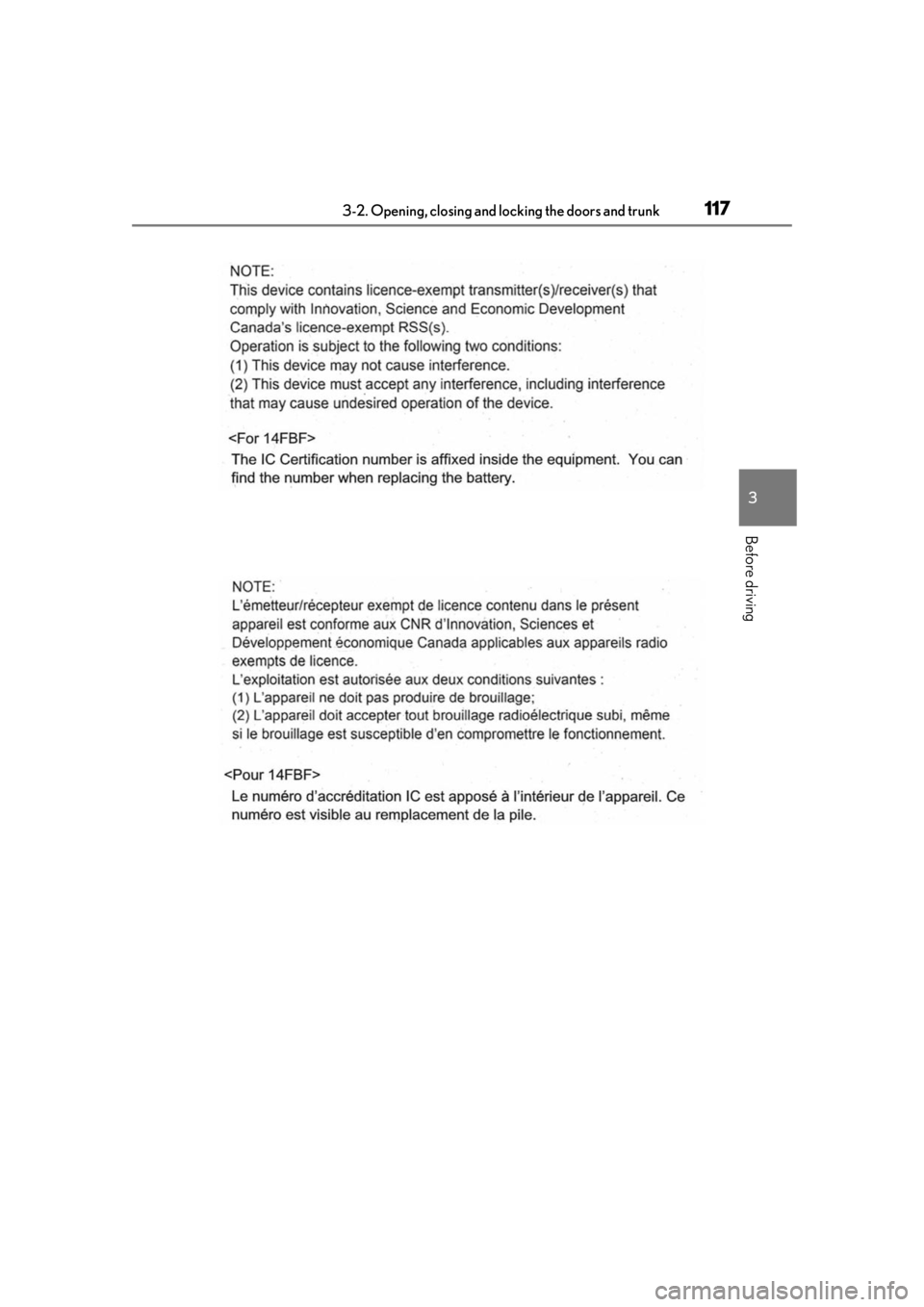
1173-2. Opening, closing and locking the doors and trunk
3
Before driving
Page 118 of 516
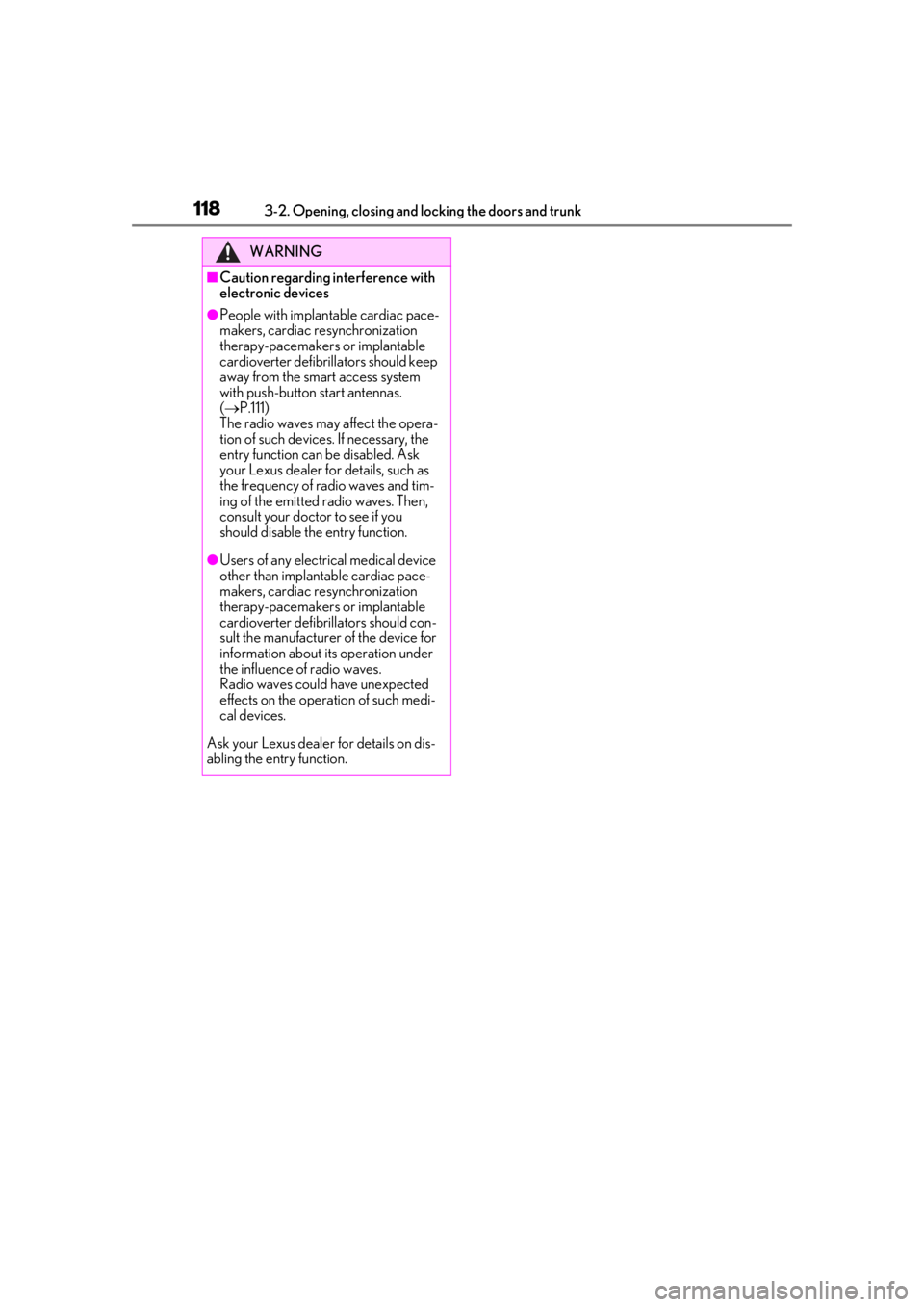
1183-2. Opening, closing and locking the doors and trunk
WARNING
â Caution regarding interference with
electronic devices
âPeople with implantable cardiac pace-
makers, cardiac resynchronization
therapy-pacemakers or implantable
cardioverter defibrillators should keep
away from the smart access system
with push-button start antennas.
(ï® P.111)
The radio waves may affect the opera-
tion of such devices. If necessary, the
entry function can be disabled. Ask
your Lexus dealer for details, such as
the frequency of radio waves and tim-
ing of the emitted radio waves. Then,
consult your doctor to see if you
should disable the entry function.
âUsers of any electrical medical device
other than implantable cardiac pace-
makers, cardiac resynchronization
therapy-pacemakers or implantable
cardioverter defibrillators should con-
sult the manufacturer of the device for
information about its operation under
the influence of radio waves.
Radio waves could have unexpected
effects on the operation of such medi-
cal devices.
Ask your Lexus dealer for details on dis-
abling the entry function.
Page 119 of 516
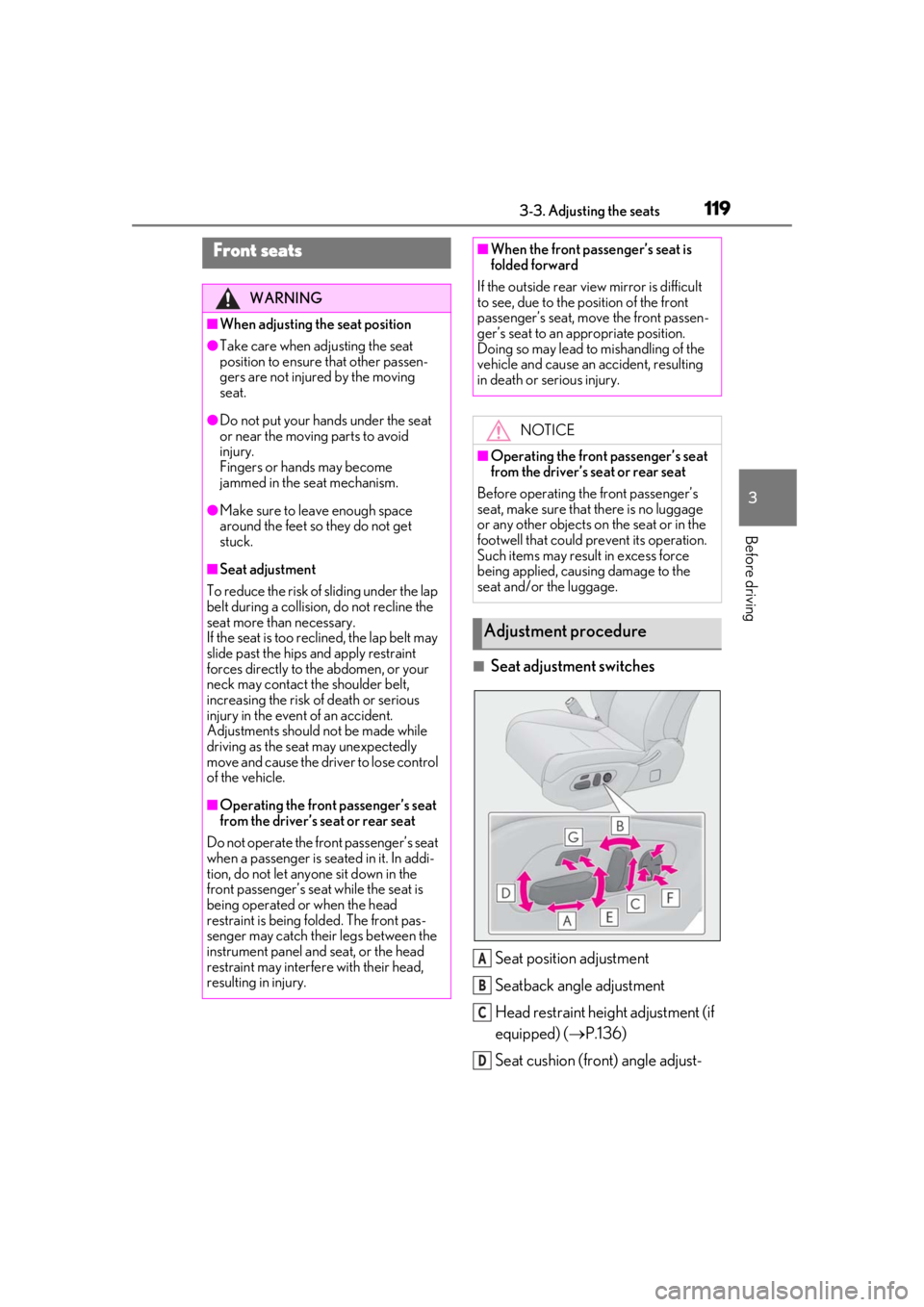
1193-3. Adjusting the seats
3
Before driving
3-3.Adjusting the seats
â Seat adjustment switchesSeat position adjustment
Seatback angle adjustment
Head restraint height adjustment (if
equipped) ( ï®P.136)
Seat cushion (front) angle adjust-
Front seats
WARNING
â When adjusting the seat position
âTake care when ad justing the seat
position to ensure that other passen-
gers are not injured by the moving
seat.
âDo not put your hands under the seat
or near the moving parts to avoid
injury.
Fingers or hands may become
jammed in the se at mechanism.
âMake sure to leave enough space
around the feet so they do not get
stuck.
â Seat adjustment
To reduce the risk of sliding under the lap
belt during a collision, do not recline the
seat more than necessary.
If the seat is too reclined, the lap belt may
slide past the hips and apply restraint
forces directly to the abdomen, or your
neck may contact the shoulder belt,
increasing the risk of death or serious
injury in the event of an accident.
Adjustments should not be made while
driving as the seat may unexpectedly
move and cause the driver to lose control
of the vehicle.
â Operating the front passengerâs seat
from the driverâs seat or rear seat
Do not operate the front passengerâs seat
when a passenger is seated in it. In addi-
tion, do not let anyone sit down in the
front passengerâs seat while the seat is
being operated or when the head
restraint is being folded. The front pas-
senger may catch their legs between the
instrument panel and seat, or the head
restraint may interfer e with their head,
resulting in injury.
â When the front passengerâs seat is
folded forward
If the outside rear view mirror is difficult
to see, due to the position of the front
passengerâs seat, move the front passen-
gerâs seat to an appropriate position.
Doing so may lead to mishandling of the
vehicle and cause an accident, resulting
in death or serious injury.
NOTICE
â Operating the front passengerâs seat
from the driverâs seat or rear seat
Before operating the front passengerâs
seat, make sure that there is no luggage
or any other objects on the seat or in the
footwell that could prevent its operation.
Such items may result in excess force
being applied, causing damage to the
seat and/or the luggage.
Adjustment procedure
A
B
C
D
Page 120 of 516
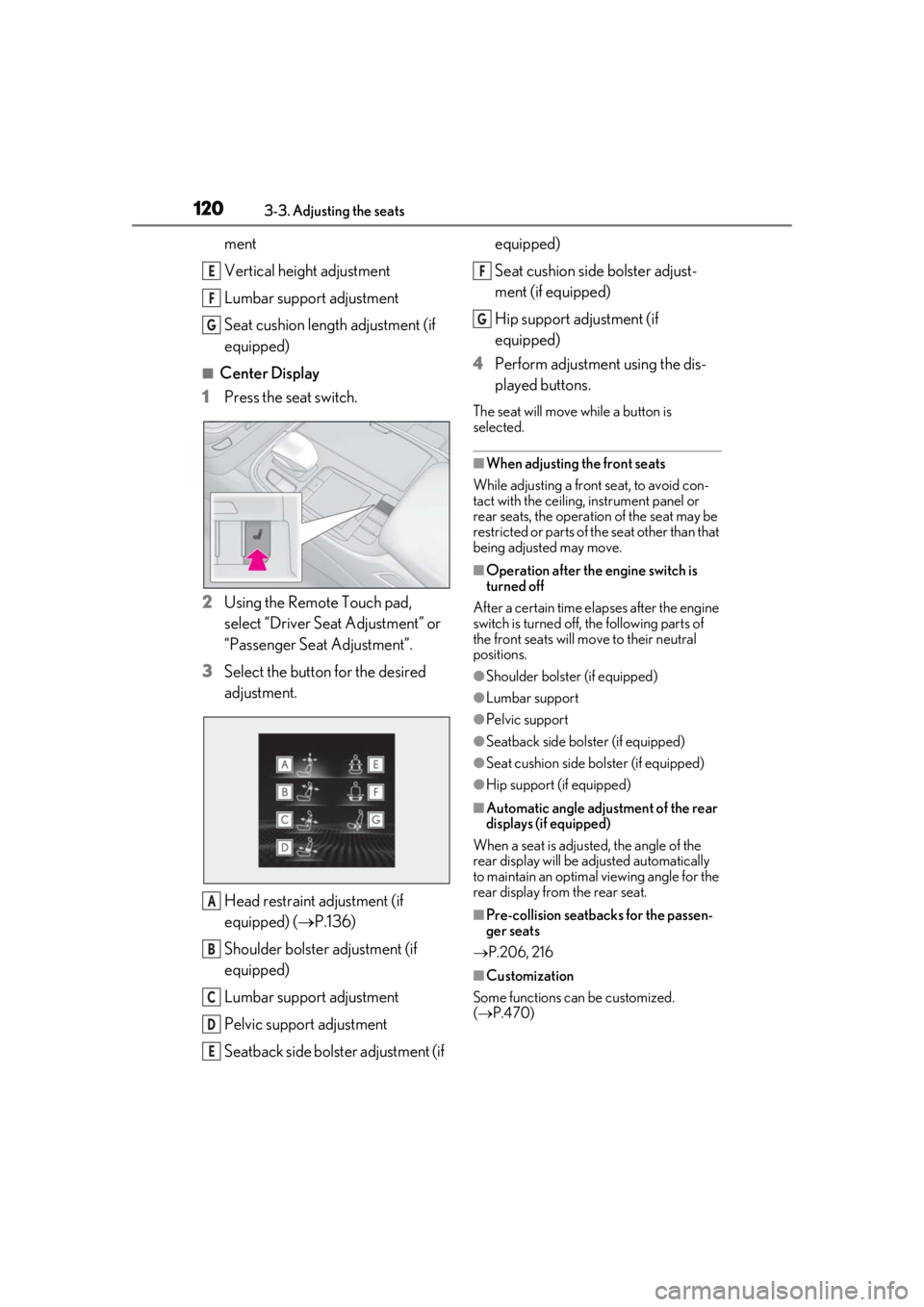
1203-3. Adjusting the seats
ment
Vertical height adjustment
Lumbar support adjustment
Seat cushion length adjustment (if
equipped)
â Center Display
1 Press the seat switch.
2 Using the Remote Touch pad,
select âDriver Seat Adjustmentâ or
âPassenger Seat Adjustmentâ.
3 Select the button for the desired
adjustment.
Head restraint adjustment (if
equipped) (ï® P.136)
Shoulder bolster adjustment (if
equipped)
Lumbar support adjustment
Pelvic support adjustment
Seatback side bolster adjustment (if equipped)
Seat cushion side bolster adjust-
ment (if equipped)
Hip support adjustment (if
equipped)
4 Perform adjustment using the dis-
played buttons.
The seat will move while a button is
selected.
â When adjusting the front seats
While adjusting a front seat, to avoid con-
tact with the ceiling, instrument panel or
rear seats, the operation of the seat may be
restricted or parts of th e seat other than that
being adjusted may move.
â Operation after the engine switch is
turned off
After a certain time elapses after the engine
switch is turned off, the following parts of
the front seats will move to their neutral
positions.
âShoulder bolster (if equipped)
âLumbar support
âPelvic support
âSeatback side bolster (if equipped)
âSeat cushion side bolster (if equipped)
âHip support (if equipped)
â Automatic angle adjustment of the rear
displays (if equipped)
When a seat is adjusted, the angle of the
rear display will be adjusted automatically
to maintain an optimal viewing angle for the
rear display from the rear seat.
â Pre-collision seatback s for the passen-
ger seats
ï® P.206, 216
â Customization
Some functions can be customized.
( ï® P.470)
E
F
G
A
B
C
D
E
F
G